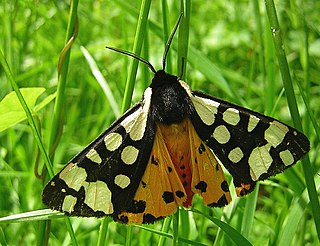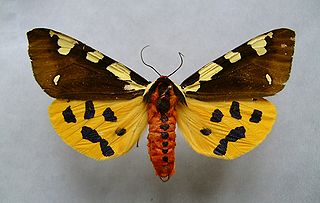
The Arctiina are a subtribe of moths in the family Erebidae.

Arctia is a genus of tiger moths in the family Erebidae. Therein, it belongs to the subtribe Arctiina in the tribe Arctiini in the subfamily Arctiinae. Species are well distributed throughout North America, Palearctic, India, and Sri Lanka.

Arctia menetriesii, the Menetries' tiger moth, is a species of tiger moth in the family Erebidae. It was first described by Eduard Friedrich Eversmann in 1846. It is found in Karelia, Oktyabrskoe, northeastern Kazakhstan, Altai Mountains, Sayan Mountains, Evenkia, Yakutia, the central Amur region, Primorsky Krai and central Sakhalin. It was believed to be extinct in Fennoscandia, but the species has been recently recorded in Finland. This species is characterized by the fact that they never come to light; such behavior is atypical in the family Arctiidae.

Arctia villica, the cream-spot tiger, is a moth of the family Erebidae. The species was first described by Carl Linnaeus in his 1758 10th edition of Systema Naturae. It is distributed from the Iberian Peninsula, Anatolia, western and northern Iran, western Siberia, southwestern Asia and North Africa.

Arctia is species of tiger moth in the family Erebidae. It was first described by Carl Linnaeus in his 1758 10th edition of Systema Naturae. It can be found in central and eastern Europe, Kazakhstan, southern Siberia, northern Mongolia, Amur Region, Primorye, Sakhalin, Kunashir, northern and northeastern China, Korea and Japan.

Arctia tigrina is a moth of the family Erebidae. It is found on the Iberian Peninsula and the South of France and Italy.

Arctia aulica, the brown tiger moth, is a moth of the family Erebidae. The species was first described by Carl Linnaeus in his 1758 10th edition of Systema Naturae. It is found in the temperate areas of central Europe up to the area surrounding the Amur River to the east and up to the Balkans and the Black Sea to the south.

Arctia dejeani is a species of moth in the family Erebidae first described by Jean Baptiste Godart in 1822. It is found on the Iberian Peninsula.
Arctia seitzi is a moth of the family Erebidae. It was described by Andreas Bang-Haas in 1910. It is found in central Asia, including Kazakhstan and Kirghizia.
Arctia thibetica is a species of tiger moth in the family Erebidae, found in the northwestern Himalayas of India.
Arctia dido is a moth of the family Erebidae. It was described by M. Wagner in 1841. It is found in Algeria.
Arctia ungemachi is a moth of the family Erebidae. It was described by Ferdinand Le Cerf in 1924. It is found in Morocco.

Arctia testudinaria, or Patton's tiger, is a moth of the family Erebidae. It was described by Geoffroy in 1785. It is found from northern Spain to southern and central France and southern Switzerland to north-eastern and southern Italy. It has also been recorded from Great Britain. The habitat consists of grasslands, slopes, forest edges, clear dry forests, cliffs and mountain slopes, maquis, garrigues and dry meadows.
Arctia weigerti is a moth of the family Erebidae. It was described by Josef J. de Freina and Thomas Joseph Witt in 1985. It is found in northern Pakistan (Karakorum).
Arctia bundeli is a moth of the family Erebidae. It was described by Vladimir Viktorovitch Dubatolov and Vladimir O. Gurko in 2004. It is found in Tajikistan.
Arctia ornata is a moth in the family Erebidae. It was described by Otto Staudinger in 1896. It is found in the Russian Far East and Mongolia.
Arctia murzini is a moth in the family Erebidae. It was described by Vladimir Viktorovitch Dubatolov in 2005. It is found in Shaanxi, China.
Arctia allardi is a moth in the family Erebidae. It was described by Charles Oberthür in 1911. It is found in China.
Arctia kasnakovi is a moth in the family Erebidae. It was described by Vladimir Viktorovitch Dubatolov in 1987. It is found in Qinghai, China.

Chelis gratiosa is a moth in the family Erebidae. It was described by Grigory Grum-Grshimailo in 1890. It is found in the western Tien Shan, the Pamir-Alay, Kyrgyzstan, Turkestan, Hissar, Trans-Alai, the Pamir Mountains, Pakistan, Kashmir and western China.









